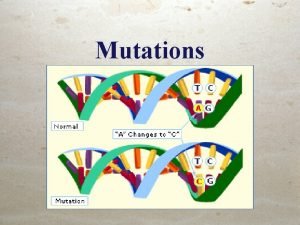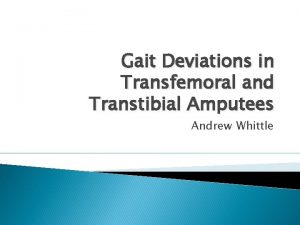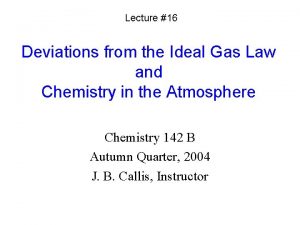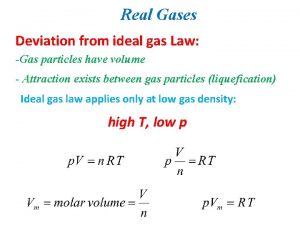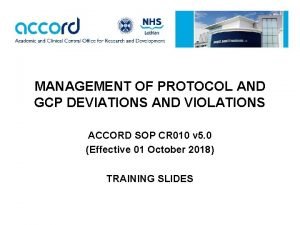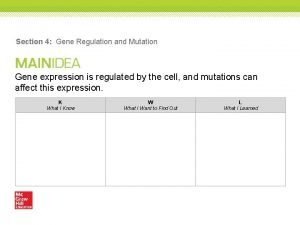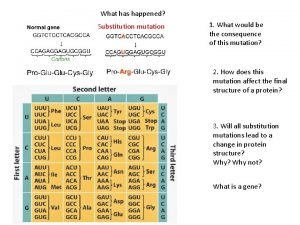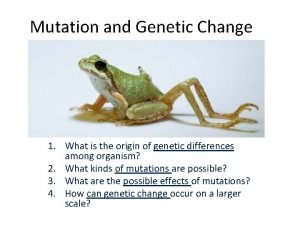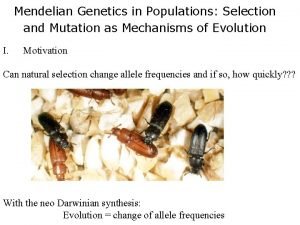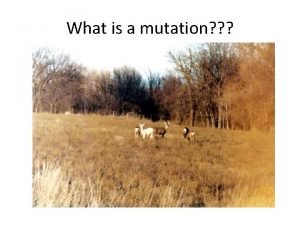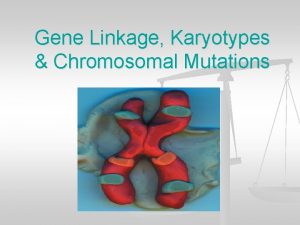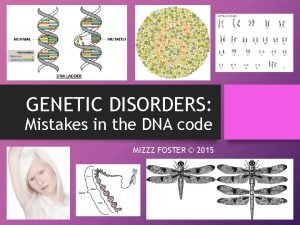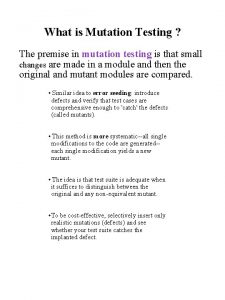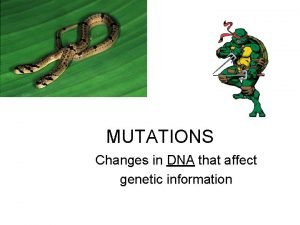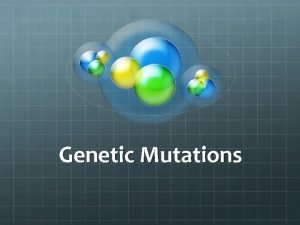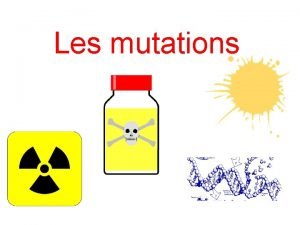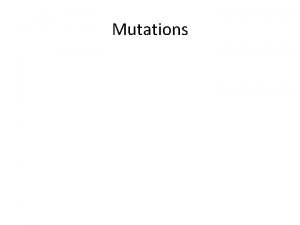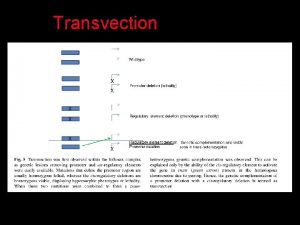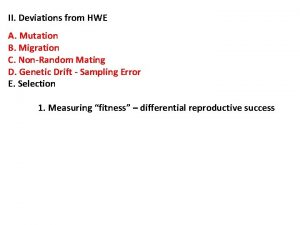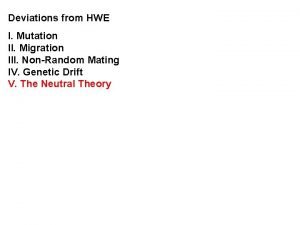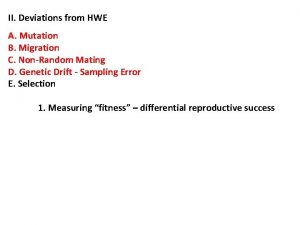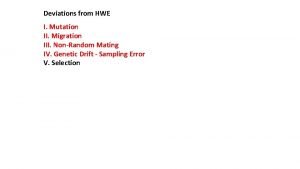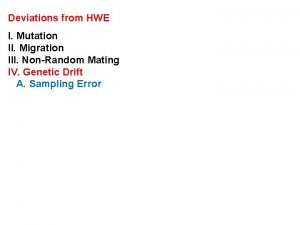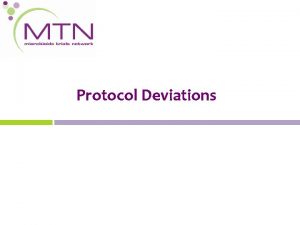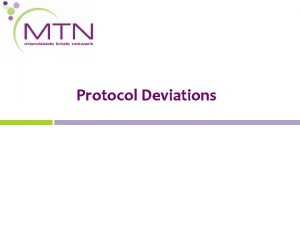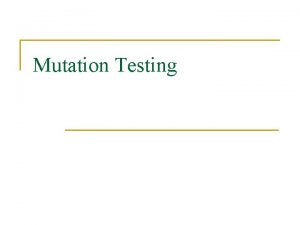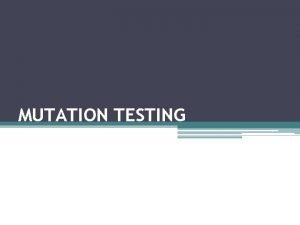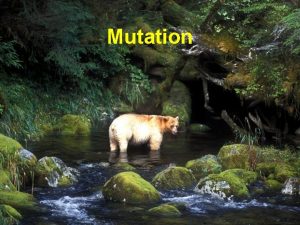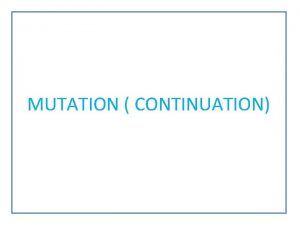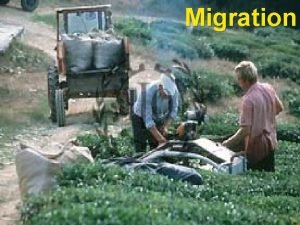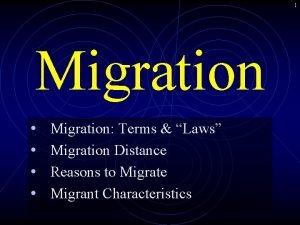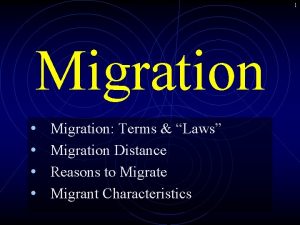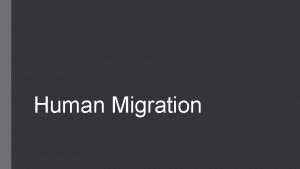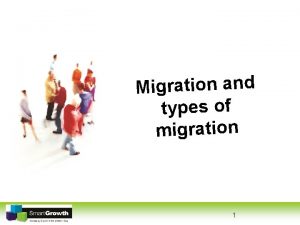D Deviations from HWE 1 mutation 2 migration























- Slides: 23

D. Deviations from HWE 1. mutation 2. migration 3. Non-random Mating 4. Finite Population Sizes: Genetic Drift The organisms that actually reproduce in a population may not be representative of the genetics structure of the population; they may vary just due to sampling error

D. Deviations from HWE 1. mutation 2. migration 3. Non-random Mating 4. Finite Population Sizes: Genetic Drift 1 - small pops will differ more, just by chance, from the original population

D. Deviations from HWE 1. mutation 2. migration 3. Non-random Mating 4. Finite Population Sizes: Genetic Drift 1 - small pops will differ more, just by chance, from the original population 2 - small pops will vary more from one another than large

D. Deviations from HWE 1. mutation 2. migration 3. Non-random Mating 4. Finite Population Sizes: Genetic Drift - “Founder Effect” The Amish, a very small, close-knit group decended from an initial population of founders, has a high incidence of genetic abnormalities such as polydactyly

- “Founder Effect” and Huntington’s Chorea HC is a neurodegenerative disorder caused by an autosomal lethal dominant allele. The fishing villages around Lake Maracaibo in Venezuela have the highest incidence of Huntington’s Chorea in the world, approaching 50% in some communities. The gene was mapped to chromosome 4, and the HC allele was caused by a repeated sequence of over 35 “CAG’s”. Dr. Nancy Wexler found homozygotes in Maracaibo and described it as the first truly dominant human disease (most are incompletely dominant and cause death in the homozygous condition).

- “Founder Effect” and Huntington’s Chorea HC is a neurodegenerative disorder caused by an autosomal lethal dominant allele. The fishing villages around Lake Maracaibo in Venezuela have the highest incidence of Huntington’s Chorea in the world, approaching 50% in some communities. By comparing pedigrees, she traced the incidence to a single woman who lived 200 years ago. When the population was small, she had 10 children who survived and reproduced. Folks with HC now trace their ancestry to this lineage.

- “Genetic Bottleneck” If a population crashes (perhaps as the result of a plague) there will be both selection and drift. There will be selection for those resistant to the disease (and correlated selection for genes close to the genes conferring resistance), but there will also be drift at other loci simply by reducing the size of the breeding population. European Bison, hunted to 12 individuals, now number over 1000. Cheetah have very low genetic diversity, suggesting a severe bottleneck in the past. They can even exchange skin grafts without rejection… Elephant seals fell to 100’s in the 1800 s, now in the 100, 000’s

Modern Evolutionary Biology I. Population Genetics A. Overview B. The Genetic Structure of a Population C. The Hardy-Weinberg Equilibrium Model D. Deviations From HWE: 1. Mutation 2. Migration 3. Non-Random Mating: 4. Populations of Finite Size and Sampling Error - "Genetic Drift" 5. Natural Selection: “differential reproductive success” we measure reproductive success as ‘fitness’ 1. Fitness Components:

D. Deviations From HWE: 5. Natural Selection 1. Fitness Components: Fitness = The mean number of reproducing offspring / genotype - probability of surviving to reproductive age - number of offspring - probability that offspring survive to reproductive age

D. Deviations From HWE: 5. Natural Selection 1. Fitness Components: Fitness = The mean number of reproducing offspring / genotype 2. Constraints: - probability of surviving to reproductive age - number of offspring - probability that offspring survive to reproductive age i. finite energy budgets and necessary trade-offs:

D. Deviations From HWE: 5. Natural Selection 1. Fitness Components: Fitness = The mean number of reproducing offspring / genotype 2. Constraints: - probability of surviving to reproductive age - number of offspring - probability that offspring survive to reproductive age i. finite energy budgets and necessary trade-offs: GROWTH METABOLISM REPRODUCTION

D. Deviations From HWE: 5. Natural Selection 1. Fitness Components: 2. Constraints: i. finite energy budgets and necessary trade-offs: TRADE OFF #1: Survival vs. Reproduction Maximize probability of survival Maximize reproduction GROWTH METABOLISM REPRODUCTION

D. Deviations From HWE: 5. Natural Selection 1. Fitness Components: 2. Constraints: i. finite energy budgets and necessary trade-offs: TRADE OFF #1: Survival vs. Reproduction TRADE OFF #2: Lots of small offspring vs. few large offspring REPRODUCTION METABOLISM Lots of small, low prob of survival A few large, high prob of survival

D. Deviations From HWE: 5. Natural Selection 1. Fitness Components: 2. Constraints: i. ii. finite energy budgets and necessary trade-offs: Contradictory selective pressures: Photosynthetic potential Water Retention Leaf Size

D. Deviations From HWE: 5. Natural Selection 1. Fitness Components: 2. Constraints: i. ii. finite energy budgets and necessary trade-offs: Contradictory selective pressures: Rainforest understory – dark, wet Photosynthetic potential Water Retention Big leaves adaptive Leaf Size

D. Deviations From HWE: 5. Natural Selection 1. Fitness Components: 2. Constraints: i. ii. finite energy budgets and necessary trade-offs: Contradictory selective pressures: Desert – sunny, dry Small leaves adaptive Leaf Size Photosynthetic potential Water Retention

D. Deviations From HWE: 5. Natural Selection 1. Fitness Components: 2. Constraints: 3. Modeling Selection: a. Calculating relative fitness p = 0. 4, q = 0. 6 AA Aa aa Parental "zygotes" 0. 16 0. 48 0. 36 prob. of survival (fitness) 0. 8 0. 4 0. 2 Relative Fitness 0. 8/0. 8=1 0. 4/0. 8 = 0. 5 0. 2/0. 8=0. 25 = 1. 00 Calculate relative fitness by dividing all fitness values by the LARGEST value.

D. Deviations From HWE: 5. Natural Selection 1. Fitness Components: 2. Constraints: 3. Modeling Selection: a. Calculating relative fitness b. Modeling Selection p = 0. 4, q = 0. 6 AA Aa aa Parental "zygotes" 0. 16 0. 48 0. 36 prob. of survival (fitness) 0. 8 0. 4 0. 2 Relative Fitness 1 0. 5 0. 25 Survival to Reproduction 0. 16 0. 24 0. 09 = 1. 00 = 0. 49 Multiply the initial genotypic frequency by relative fitness. Of course, not all organisms have survived, so these new frequencies do not sum to 1 any more.

D. Deviations From HWE: 5. Natural Selection 1. Fitness Components: 2. Constraints: 3. Modeling Selection: a. Calculating relative fitness b. Modeling Selection p = 0. 4, q = 0. 6 AA Aa aa Parental "zygotes" 0. 16 0. 48 0. 36 prob. of survival (fitness) 0. 8 0. 4 0. 2 Relative Fitness 1 0. 5 0. 25 Survival to Reproduction 0. 16 0. 24 0. 09 = 0. 49 Freq’s in Breeding Adults 0. 16/0. 49 = 0. 33 0. 24/0. 49 = 0. 49 0. 09/0. 49 = 0. 18 = 1. 00 But we need to know what FRACTION of these SURVIVORS has each genotype. So, divide each frequency by the total. THESE are the genotypic frequencies in the survivors that have reached reproductive age and will breed.

D. Deviations From HWE: 5. Natural Selection 1. Fitness Components: 2. Constraints: 3. Modeling Selection: a. Calculating relative fitness b. Modeling Selection p = 0. 4, q = 0. 6 AA Aa aa Parental "zygotes" 0. 16 0. 48 0. 36 prob. of survival (fitness) 0. 8 0. 4 0. 2 Relative Fitness 1 0. 5 0. 25 Survival to Reproduction 0. 16 0. 24 0. 09 = 0. 49 Freq’s in Breeding Adults 0. 16/0. 49 = 0. 33 0. 24/0. 49 = 0. 49 0. 09/0. 49 = 0. 18 = 1. 00 Gene Frequencies F(A) = 0. 575 Freq’s in F 1 (p 2, 2 pq, q 2) 0. 33 0. 49 = 1. 00 F(a) = 0. 425 0. 18 = 1. 00 Calculate the gene frequencies, and compute genotypes in offspring (assuming all other HWE conditions are met, like random mating. )

D. Deviations From HWE: 5. Natural Selection 1. 2. 3. 4. Fitness Components: Constraints: Modeling Selection: Types of Selection

D. Deviations From HWE: 5. Natural Selection 1. 2. 3. 4. Fitness Components: Constraints: Modeling Selection: Types of Selection Sexual Selection Some traits that decrease survival may be selected for because they have a direct and disproportional benefit on probability of mating. Intrasexual – competition within a sex for access to mates. Intersexual – mates are chosen by the opposite sex.

Modern Evolutionary Biology I. Population Genetics A. Overview B. The Genetic Structure of a Population C. The Hardy-Weinberg Equilibrium Model D. Deviations From HWE E. Summary; The Modern Synthetic Theory of Evolution Agents of Change Mutation Natural Selection Recombination - crossing over - independent assortment VARIATION Sources of Variation Genetic Drift Migration Mutation Non-random Mating
 Chromosomal mutation vs gene mutation
Chromosomal mutation vs gene mutation Circumduction gait
Circumduction gait Deviations from the ideal gas law
Deviations from the ideal gas law Protocol deviations categories
Protocol deviations categories Deviation from ideal gas law
Deviation from ideal gas law Gcp deviation
Gcp deviation How to solve for mean absolute deviation
How to solve for mean absolute deviation Section 4 gene regulation and mutation
Section 4 gene regulation and mutation What is the result of a substitution mutation?
What is the result of a substitution mutation? Genetic drift
Genetic drift Underdominance
Underdominance Glu to val mutation
Glu to val mutation Anemia
Anemia Karyotype mutations
Karyotype mutations Mizzz foster
Mizzz foster What is mutation
What is mutation Criminal syndrome
Criminal syndrome Dna mutation
Dna mutation Chromosome mutation types
Chromosome mutation types Dna mutation
Dna mutation Somatic mutations
Somatic mutations Mutation isosemantique
Mutation isosemantique Chromosomal mutation
Chromosomal mutation Hox gene mutation in drosophila
Hox gene mutation in drosophila
